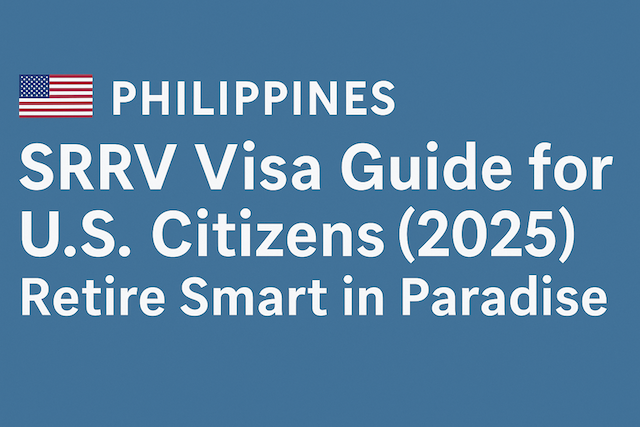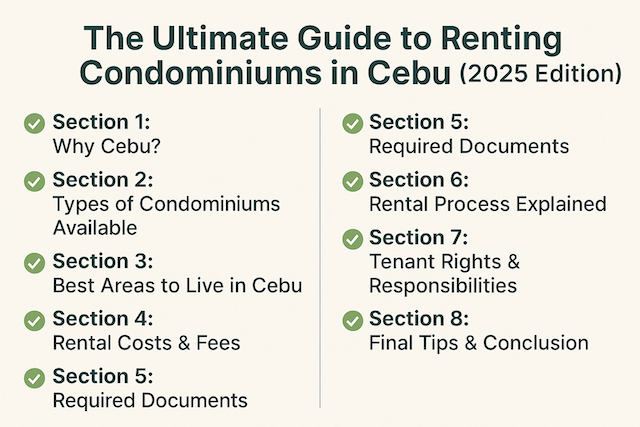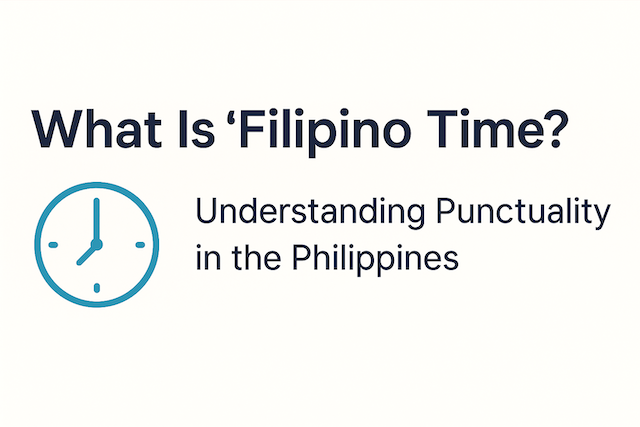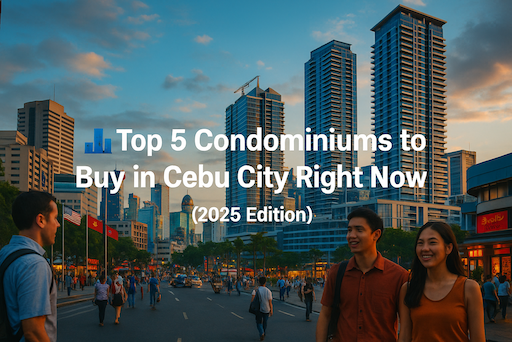Philippines SRRV Visa Guide for U.S. Citizens (2025): Retire Smart in Paradise
内容
- 1 Philippines SRRV Visa Guide for U.S. Citizens (2025): Retire Smart in Paradise
- 1.1 ✍️ はじめに
- 1.2 🇵🇭 1. What Is the SRRV?
- 1.3 🏷️ Current SRRV Options (As of 2025)
- 1.4 🇺🇸 2. Eligibility Requirements for U.S. Citizens
- 1.5 🇵🇭 3. How to Apply for the SRRV
- 1.6 🇵🇭 4. Financial and Tax Benefits of the SRRV
- 1.7 🇺🇸 5. Common Questions & Practical Tips for U.S. Citizens
- 1.7.1 ❓ Q1: Can I still receive my U.S. Social Security or pension while living in the Philippines?
- 1.7.2 ❓ Q2: Do I need to pay U.S. taxes even if I live in the Philippines full time?
- 1.7.3 ❓ Q3: Can I work or start a business with the SRRV?
- 1.7.4 ❓ Q4: What about healthcare? Is it safe and affordable?
- 1.7.5 ❓ Q5: Can I travel in and out of the Philippines easily with the SRRV?
- 1.7.6 🧭 Practical Tips for Americans Moving to the Philippines:
- 1.8 🇵🇭 6. Final Thoughts: Is the SRRV Right for You?
- 1.9 👤 Case Study: How One American Retiree Found a New Life in the Philippines
- 1.10 📍 Area Comparison: Cebu vs Manila vs Davao
- 1.11 🗓️ Life Roadmap After Getting Your SRRV: What to Do in the First 6 Months
- 1.12 🎯 The Goal?
- 1.13 💬 Final Word
- 1.14 💬 Final Word: Why the SRRV Might Be the Smartest Move You’ll Ever Make
- 1.15 📌 Ready to Take the First Step?
Philippines SRRV Visa Guide for U.S. Citizens (2025): Retire Smart in Paradise
✍️ はじめに
Are you an American citizen considering retirement or long-term relocation abroad?
With rising costs of living, growing healthcare expenses, and an increasingly uncertain economic climate in the United States, more and more Americans are looking overseas for a better quality of life — one that’s affordable, peaceful, and still offers a strong connection to the English-speaking world.
を入力する。 フィリピン — a tropical archipelago in Southeast Asia that not only boasts stunning beaches and warm weather year-round, but also a deeply hospitable culture, widespread English fluency, and most importantly: a visa program specifically designed to welcome foreign retirees and long-term residents.
It’s called the Special Resident Retiree’s Visa (SRRV).
The SRRV is not just a tourist visa with a long extension. It’s a powerful, government-backed program that allows foreign nationals — including Americans — to live indefinitely in the Philippines, with multiple entry privileges, no minimum stay requirement, tax exemptions, and even the right to start a business or work under certain conditions.
In fact, the Philippines has quietly become one of the top retirement destinations for U.S. citizens. As of 2025, thousands of Americans have already made the move — some for the low cost of living, others for the warm climate and vibrant expat communities, and many because of the unique financial and legal advantages offered by the SRRV.
This guide is designed specifically for U.S. citizens who want to explore the SRRV program in detail — from eligibility and requirements, to financial commitments, to the step-by-step application process. Whether you’re looking to retire early, start a new business abroad, or simply live more comfortably on your savings, this article will show you why the Philippines may be the most practical and rewarding option for your next chapter.
So if you’ve ever dreamed of living by the beach, enjoying affordable healthcare, and being part of a welcoming international community — all while speaking English and staying close to American values — the SRRV might just be your golden ticket.
さあ、飛び込もう。
🇵🇭 1. What Is the SRRV?
について Special Resident Retiree’s Visa (SRRV) is a long-term visa program administered by the Philippine Retirement Authority (PRA), a government agency under the Department of Tourism. Originally established in 1985, the program aims to attract foreign nationals—especially retirees and long-stay visitors—to settle in the Philippines through a streamlined, investment-friendly residency process.
Unlike tourist visas that require frequent renewals, the SRRV allows indefinite stay in the Philippines with multiple-entry privileges, no annual exit requirementsそして flexibility to invest, lease property, or even work under certain conditions. This makes it an attractive option for U.S. citizens seeking a cost-effective, English-speaking base in Asia.
🛡️ Key Features of the SRRV:
| 特徴 | 説明 |
|---|---|
| 🗓 Validity | Indefinite stay as long as you maintain your visa |
| 🔄 Re-entry | Multiple-entry, no annual exit required |
| 💼 Business & Employment | May apply for work or start a business (with additional permits) |
| 🏦 Tax Benefits | Exempt from Philippine income tax on foreign pensions and annuities |
| 🏘️ Real Estate | Eligible to lease long-term or purchase condominiums |
| 👨👩👧👦 Dependents | Spouse and unmarried children under 21 may be included |
| 📈 Investment-Based | Requires a time deposit or real estate investment in the Philippines |
Thousands of U.S. citizens have already obtained the SRRV to enjoy a peaceful retirement, launch small businesses, or establish a base in Asia. Compared to similar programs in Thailand or Malaysia, the SRRV remains one of the most flexible and affordable residency options in the region.
🏷️ Current SRRV Options (As of 2025)
As of 2025, the following SRRV visa types are available:
| SRRV Type | Who It’s For | 預金条件 |
|---|---|---|
| SRRV Classic | Foreign nationals aged 50+ | $10,000–$20,000 (depends on pension status) |
| SRRV Courtesy | Former Filipino citizens or retired foreign diplomats | $1,500 |
| SRRV Expanded Courtesy | Retired military personnel from countries with ties to the Philippines (e.g., U.S. veterans) | $1,500 |
注: Previous options such as SRRV Smile そして SRRV Human Touch have been officially discontinued as of 2023 due to updated policies and security concerns.
The most popular option for U.S. citizens is the SRRV Classic, which allows the required deposit to be either kept in a Philippine bank or converted into a qualifying real estate investment (e.g., the purchase or long-term lease of a condominium unit). This makes it especially attractive to those seeking both flexibility and tangible value from their visa investment.
🇺🇸 2. Eligibility Requirements for U.S. Citizens
The Philippines offers a relatively accessible and straightforward path for American retirees and long-term residents to apply for the SRRV. However, there are several key requirements that applicants must meet depending on the specific SRRV type they choose — particularly the SRRV Classic, which is the most commonly used option by U.S. citizens.
✅ General Eligibility Criteria:
To qualify for the SRRV (Special Resident Retiree’s Visa), U.S. citizens must meet the following conditions:
| 必要条件 | 説明 |
|---|---|
| Age | Minimum 50 years old (SRRV Classic); No upper limit |
| Health | Must be physically healthy and pass a medical exam from a PRA-accredited clinic |
| Criminal Record | Must have no derogatory or criminal record (NBI Clearance in the Philippines + Police Clearance from the U.S.) |
| Financial Capacity | Must meet the financial deposit requirements (varies by visa type) |
| Valid Passport | Must have a passport valid for at least 6 months at time of application |
| Valid Visa | Must enter the Philippines on a tourist visa (can be converted to SRRV while in-country) |
💰 Deposit Requirements for SRRV Classic:
The SRRV Classic program is divided into two financial categories:
| Applicant Type | Required Deposit | 備考 |
|---|---|---|
| With Pension | USD $10,000 | Must show at least USD $800 monthly pension (single) or $1,000 (couple) |
| Without Pension | USD $20,000 | Lump-sum deposit; no monthly income proof required |
This deposit must be placed in a PRA-accredited bank (such as Land Bank or DBP). After approval, the deposit may remain in the bank or be used to purchase a freehold condominium または long-term leasehold property valued at $50,000 or more.
💡 Tip: Many applicants use their SRRV deposit to purchase a condo unit in cities like Cebu or Metro Manila, turning their visa into an investment opportunity.
👨👩👧👦 Adding Dependents:
You can include the following family members in your SRRV application:
-
Spouse (legally married, same or opposite sex)
-
Children under 21 (unmarried and dependent)
To include dependents, the deposit amount may increase slightly (usually an additional $15,000 for the first dependent if no pension is provided), or you may need to show a higher pension if applying under the “with pension” category.
📄 Required Documents (for U.S. Citizens):
Here is a summary of what you’ll typically need to submit during the SRRV application process:
-
Valid Passport with Philippine entry stamp
-
Police Clearance from the U.S. (FBI background check recommended)
-
NBI Clearance (once in the Philippines)
-
PRA Application Form
-
Medical Certificate (from a PRA-accredited clinic)
-
Proof of Pension (if applicable)
-
SRRV Deposit Receipt
-
Passport-sized Photos (12 copies)
-
Marriage Certificate (if spouse included)
-
Birth Certificate(s) for children (if applicable)
🇵🇭 3. How to Apply for the SRRV
Applying for the Special Resident Retiree’s Visa (SRRV) is relatively straightforward — especially when compared to more complex immigration systems like those in the U.S. or Europe. The process can be initiated either inside the Philippines (after entering on a tourist visa) or through an accredited representative abroad, although most U.S. citizens apply in-country for faster processing.
Here’s a step-by-step breakdown:
📝 Step-by-Step Application Process
| ステップ | 説明 |
|---|---|
| 1. Arrive in the Philippines | Most applicants enter the country on a 30-day tourist visa (which can be extended). Make sure your passport is valid for at least 6 months. |
| 2. Open a PRA-Accredited Bank Account | Deposit the required SRRV amount (USD $10,000–$20,000) into a designated time deposit account at a PRA partner bank. You’ll receive a deposit certificate to include with your application. |
| 3. Undergo a Medical Check-Up | Complete a medical examination at a PRA-accredited clinic or hospital. Results are submitted with the application. |
| 4. Submit Police & NBI Clearances | Provide an FBI clearance from the U.S. (or police clearance) and get an NBI clearance once you’ve been in the Philippines for more than 30 days. |
| 5. Submit Application to PRA | File your complete application with the Philippine Retirement Authority (PRA). You can do this directly at PRA headquarters in Makati or through a registered agent. |
| 6. Wait for Approval (2–4 weeks) | PRA reviews your documents and verifies your background, health, and deposit. Most applications are processed within 2–4 weeks. |
| 7. Receive Your SRRV ID & ACR I-Card | Once approved, you’ll receive your official SRRV ID, which grants you residency, and your ACR I-Card (Alien Certificate of Registration). No need to leave the country. |
📌 Important Notes:
-
You must maintain your time deposit or qualified real estate investment to keep your SRRV active.
-
If you leave the Philippines for more than one year, you may need to revalidate your documents upon return.
-
Annual reporting is required but simpler than the tourist visa extension process.
🤝 Need Help?
While you can apply independently, many U.S. citizens choose to work with a PRA-accredited agent to simplify the paperwork and ensure everything runs smoothly. Agents can assist with document preparation, real estate guidance, and translating medical or legal forms when necessary.
🇵🇭 4. Financial and Tax Benefits of the SRRV
One of the biggest advantages of the SRRV program — and a major reason it’s so popular among U.S. retirees — lies in its financial flexibility and tax-friendly structure. In addition to being one of the lowest-cost retirement visas in Asia, the SRRV also offers a number of fiscal incentives that make long-term living in the Philippines especially appealing.
💰 4.1 Lower Cost of Living
The cost of living in the Philippines is 著しく低い than in the United States. Retirees living in major cities like Cebu or Davao report monthly budgets of:
| カテゴリー | Monthly Cost (USD) |
|---|---|
| Rent (1BR condo in city center) | $300–$600 |
| Utilities + Internet | $80–$150 |
| Groceries + Dining Out | $200–$400 |
| Domestic Help (optional) | $100–$200 |
| Health Insurance (private) | $100–$250 |
| Total (Estimate) | $800–$1,600 |
Even with modest retirement income, U.S. citizens can enjoy a comfortable lifestyle that includes conveniences like condo living, household help, and access to quality healthcare — all at a fraction of U.S. prices.
🏦 4.2 Tax Incentives
The SRRV provides several tax exemptions and incentives, especially beneficial to those with foreign pensions or annuities:
| Tax Category | SRRV Benefit |
|---|---|
| Foreign Pensions | Exempt from Philippine income tax |
| Annuities / Social Security | Also exempt from local tax if remitted from abroad |
| Interest from Time Deposit | Exempt from Philippine withholding tax (for the SRRV deposit) |
| Capital Gains (outside PH) | Not taxed by the Philippine government |
| Estate / Inheritance Tax | Applies only to Philippine assets, not U.S. ones |
✅ This means your U.S. Social Security, 401(k), or IRA income will not be taxed by the Philippine government — only the IRS back home (unless you’re fully exempt).
💡 U.S. Tax Obligations Still Apply
It’s important to note: U.S. citizens are taxed on their worldwide income, regardless of residency. However, you may qualify for:
-
について Foreign Earned Income Exclusion (FEIE)
-
について Foreign Tax Credit (FTC)
-
Tax treaty benefits between the U.S. and the Philippines
Consider consulting a cross-border tax specialist to minimize double taxation and manage your reporting obligations (e.g., FBAR, FATCA).
📉 4.3 Real Estate as an Investment Option
Under the SRRV Classic, part of your required deposit (typically $20,000) can be converted into real estate, provided it meets PRA requirements:
-
Must be a condominium unit (foreigners cannot own land)
-
Title must be under your name
-
Value must exceed $50,000 USD
-
Located in approved urban areas (e.g., Metro Manila, Cebu, Davao)
This is a powerful way to turn your visa into a long-term asset, while avoiding the volatility of other investment vehicles. In some cases, retirees buy pre-construction units and use them as a second home or rental property.
🇺🇸 5. Common Questions & Practical Tips for U.S. Citizens
Whether you’re a first-time visitor to the Philippines or a seasoned traveler considering retirement abroad, moving permanently is a big step. Here are some of the most common questions asked by U.S. citizens — along with real-world tips to make the transition smoother.
❓ Q1: Can I still receive my U.S. Social Security or pension while living in the Philippines?
✅ そうだ。 The Philippines is one of the countries where the U.S. Social Security Administration can send payments directly. You can receive your monthly benefits via direct deposit to a local or U.S. bank. Just make sure to notify the SSA about your address abroad and complete the annual “proof of life” form.
❓ Q2: Do I need to pay U.S. taxes even if I live in the Philippines full time?
✅ そうだ。 U.S. citizens are subject to worldwide income tax, even while living abroad. However, you may reduce your liability through:
-
Foreign Earned Income Exclusion (FEIE)
-
Foreign Tax Credit (FTC)
-
Tax treaty benefits between the U.S. and Philippines
If your income is solely from Social Security or pensions, your U.S. tax liability may be minimal — but you’ll still need to file.
❓ Q3: Can I work or start a business with the SRRV?
🚫 そうだ。 The SRRV is a retirement visa, not a work visa. You are not legally allowed to hold employment or engage in business without additional permits. However, remote work for a U.S. employer or managing passive investments (like real estate rentals) is generally allowed.
❓ Q4: What about healthcare? Is it safe and affordable?
✅ Yes, with some caveats. The Philippines has many private hospitals and clinics, particularly in cities like Cebu, Manila, and Davao, that meet international standards. Many expats purchase local private health insurance (e.g., Maxicare, Pacific Cross), or maintain international insurance plans like Cigna or IMG.
Costs are far lower than in the U.S.:
-
Doctor’s visit: $10–$30
-
Private hospital room: $50–$100/day
-
Surgery (minor): Often under $2,000
Tip: Always verify if your preferred hospital is SRRV-partnered for added service perks.
❓ Q5: Can I travel in and out of the Philippines easily with the SRRV?
✅ そうだ。 The SRRV allows multiple re-entry and long-term stay privileges. You can leave and re-enter the country at will. You’re also exempt from certain exit fees that tourists pay when departing the country.
🧭 Practical Tips for Americans Moving to the Philippines:
-
Climate: It’s tropical — hot and humid. Consider locations like Tagaytay or Baguio if you prefer cooler weather.
-
Internet: Generally fast in cities, but check coverage in rural areas.
-
言語: English is widely spoken, especially in urban areas.
-
Banking: Open a local account (BDO, BPI) once you have your SRRV.
-
Safety: The Philippines is relatively safe, but use common sense — especially in unfamiliar neighborhoods at night.
🇵🇭 6. Final Thoughts: Is the SRRV Right for You?
For many Americans seeking an affordable, English-speaking, and welcoming place to retire, the フィリピン continues to rise as one of the top global destinations — and the SRRV visa is a key reason why.
With a simple application process, low financial requirements, and no age cap (for some visa types), it’s one of the most accessible long-term residency programs in the world. Add in the year-round tropical climate, low cost of living, and warm hospitality of the Filipino people, and you’ve got a strong case for choosing the Philippines as your next chapter.
✅ Who is the SRRV ideal for?
-
退職者 on a modest pension or Social Security
-
Remote workers or freelancers looking for a legal long-term base in Southeast Asia
-
U.S. veterans, who benefit from waived deposit requirements
-
Anyone who values a simple lifestyle, a vibrant expat community, and access to affordable healthcare
⚠️ Who may want to think twice?
-
Those who want to work or run a business in the Philippines (additional permits required)
-
Those with major medical needs requiring high-end hospitals (consider proximity to top-tier private care)
-
Anyone seeking a path to Philippine citizenship — SRRV is for permanent residency, but does not lead directly to citizenship
👤 Case Study: How One American Retiree Found a New Life in the Philippines
Name: John Peterson
Age: 68
Former Residence: Tampa, Florida
Monthly Income: $2,100 (Social Security + Pension)
SRRV Type: SRRV Classic (with pension)
New Home: Cebu City, Philippines
🌴 Why He Moved
John had spent over 40 years working in the logistics industry and retired in 2023. Though he owned a modest condo in Florida, rising property taxes, healthcare costs, and day-to-day living expenses were beginning to eat into his savings.
“I wasn’t living — I was just trying to keep up,” he says.
He began researching retirement destinations abroad and was drawn to the Philippines for three main reasons:
-
English-speaking environment
-
物価の安さ
-
Warm, welcoming culture
✈️ Applying for the SRRV
After reading about the SRRV online, John contacted an accredited PRA agent and began gathering documents:
-
Proof of pension income
-
FBI background check
-
診断書
-
Passport and ID photos
He chose the SRRV Classic with pension, requiring only a $10,000 deposit because of his steady monthly income.
Within two months, he was approved and ready to fly.
🏠 Life in Cebu
John settled in a serviced apartment in Cebu City for $450/month — including Wi-Fi, air conditioning, and weekly cleaning. He shops at local markets, eats out regularly, and even takes weekend trips to nearby islands like Bohol and Siquijor.
His monthly budget looks like this:
| 経費 | Monthly Cost (USD) |
|---|---|
| Rent (furnished studio) | $450 |
| Utilities & Internet | $100 |
| Food (groceries & dining) | $300 |
| Health insurance (private) | $80 |
| 交通 | $50 |
| Entertainment & travel | $100 |
| Total | $1,080 |
He saves over $1,000/month — something he never managed in the U.S.
🩺 Healthcare and Safety
John joined a local private health plan and also keeps a travel medical policy for emergencies. He regularly visits a nearby private hospital where most doctors speak fluent English.
“I feel safe and supported here,” he says. “People go out of their way to help you — it’s not like back home.”
💬 Final Thoughts from John
“The SRRV gave me options I never thought I had. I’m not just surviving anymore — I’m finally living.”
📍 Area Comparison: Cebu vs Manila vs Davao
The Philippines offers many cities for SRRV holders, but セブ, マニラそして ダバオ are by far the most popular. Here’s how they stack up for foreign retirees:
| 基準 | Cebu City 🇵🇭 | Manila (Metro) 🇵🇭 | Davao City 🇵🇭 |
|---|---|---|---|
| 生活費 | Moderate ($1,000–1,500/month) | High ($1,300–2,000/month) | Low ($900–1,300/month) |
| Healthcare Access | Good private hospitals (Cebu Doctors, Chong Hua) | Top-tier hospitals (St. Luke’s, Makati Med) | Decent care, fewer specialists |
| Safety | Generally safe, tourist-friendly | Mixed — pockets of safety and high crime | Known as one of the safest cities |
| International Airport | Mactan-Cebu Intl (MCIA) | NAIA (main hub, often congested) | Davao Intl (smaller, fewer routes) |
| Language | English widely spoken | English widely spoken | English widely spoken |
| Weather | Hot, humid, some rainy months | Hot, urban heat, flooding risk | Milder climate, less humid |
| Lifestyle | Balanced: urban + beach + nature | Very urban, nightlife, shopping | Laid-back, green, local lifestyle |
| Expat Community | Large, active (retirees + students) | Very large, diverse (business focus) | Smaller but growing expat base |
🔍 Which City Should You Choose?
-
✅ セブ is ideal for those who want balance: modern amenities, proximity to beaches, and a relaxed pace.
-
✅ マニラ works best for expats who need top-tier hospitals, embassies, or direct international flights — but it’s fast-paced and expensive.
-
✅ ダバオ offers the lowest cost of living and high safety, perfect for those who prefer nature and community over urban luxuries.
No matter where you go, your SRRV allows you to live legally, rent or buy property, and enjoy a vibrant Filipino lifestyle.
🗓️ Life Roadmap After Getting Your SRRV: What to Do in the First 6 Months
So you’ve arrived in the Philippines and your SRRV has been approved — congratulations!
But now what?
Here’s a practical 6-month roadmap to help you transition smoothly into your new life.
✅ Month 1: Settle In & Legalize Your Stay
-
🏠 Find Long-Term Housing: Whether you start in a hotel or Airbnb, aim to secure a long-term rental within the first month.
-
🧾 Register with the PRA Office: Visit your local PRA branch to complete post-arrival requirements.
-
🆔 Get Your SRRV ID Card: This is your key to proving legal residency — it usually arrives within a few weeks.
-
📱 Set Up Local Essentials: Get a local SIM card, open a bank account, and register for internet services.
✅ Month 2–3: Stabilize Your Lifestyle
-
🛒 Establish Your Routine: Find your go-to grocery stores, restaurants, and pharmacies.
-
🏥 Choose a Primary Clinic or Hospital: Tour local healthcare facilities and consider enrolling in a private health plan.
-
🧘 Explore Your Neighborhood: Try out fitness centers, parks, or hobby groups to stay active.
-
🤝 Connect with Other Expats: Join online forums or Facebook groups — this is often how lifelong friendships start.
✅ Month 4–5: Optimize for Long-Term Comfort
-
📑 Review Your Finances: Adjust your budget now that you have real cost-of-living data.
-
🖥️ Set Up Digital Tools: Use apps for local transport (Grab), bill payments (GCash), and shopping (Lazada/Shopee).
-
🧳 Take Side Trips: Explore other cities like Bohol, Palawan, or Siargao to see what else the country offers.
-
🧠 Learn Basic Filipino/Visayan: Even just a few phrases go a long way with locals.
✅ Month 6: Evaluate & Expand
-
📝 Reassess Your Living Situation: Are you happy with your city, housing, and daily life? If not, consider moving.
-
💬 Engage Locally: Volunteer, take classes, or find a hobby group — building roots takes time.
-
🛂 Confirm Visa Validity: Double-check your PRA requirements and SRRV renewal timelines.
🎯 The Goal?
To go from “newcomer” to “settled resident” within 6 months — emotionally, logistically, and socially.
By planning ahead and taking small steps each month, you’ll create a stable, fulfilling lifestyle that’s not just about surviving in a new country, but truly thriving.
💬 Final Word
If your goals include low taxes, sunshine year-round, and a friendly, affordable lifestyle, the SRRV offers an unmatched opportunity.
It’s not just a visa — it’s a lifestyle upgrade.
And while it may not suit everyone, for many U.S. citizens, the SRRV represents something rare in today’s complex immigration world:
✅ Stability, Simplicity, and Sunshine.
📌 Need Help Applying or Want to Learn More?
Our team at スタディ・イングリッシュ・ダイレクト(SED) specializes in helping U.S. citizens navigate life in the Philippines. Whether you’re just curious or ready to make the move, we’re here to guide you — from English language programs to visa assistance.
👉 Contact us today to get personalized advice and start your next great adventure.
💬 Final Word: Why the SRRV Might Be the Smartest Move You’ll Ever Make
Retirement today isn’t what it used to be.
For many U.S. citizens, the traditional path — working until 67, living on Social Security, and spending your golden years in a high-cost city — no longer makes financial or emotional sense. Rising housing prices, healthcare costs, and social isolation have left millions searching for a better way.
And that’s where the Philippines — and the Special Resident Retiree’s Visa (SRRV) — comes in.
This isn’t just another visa. It’s a gateway to a lifestyle defined by:
-
☀️ Year-round sunshine
-
💸 物価の安さ
-
🌴 Laid-back tropical pace
-
💬 English-speaking community
-
🏥 Affordable private healthcare
-
🛂 Legal residency — with no age cap or renewal hassles
More importantly, it provides something that’s getting harder to find back home:
✅ A sense of dignity, freedom, and control over your retirement.
You don’t need to be rich. You just need to be strategic.
With the SRRV, a $10,000 deposit and a modest pension can unlock a comfortable, secure life that many Americans only dream about.
And you’re not alone. Thousands of U.S. citizens have already made the move — not just to escape, but to thrive. To live more fully, spend more wisely, and feel more connected than they have in years.
📌 Ready to Take the First Step?
Whether you’re still exploring or ready to pack your bags, スタディ・イングリッシュ・ダイレクト(SED) is here to help.
We specialize in supporting U.S. citizens through:
-
🎓 English language preparation
-
🛃 Visa guidance and SRRV application
-
🏠 Life setup and relocation planning
You don’t have to figure this out alone — and you don’t have to wait until you’re “ready.”
👉 Contact us today to speak with a real advisor, get answers to your questions, and begin your journey to a new life in the Philippines.
Because sometimes, the best way to retire… is to start over — somewhere warmer, freer, and far more rewarding.







